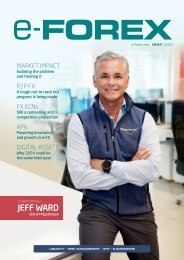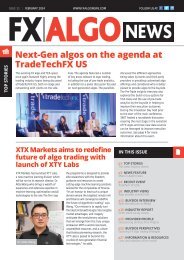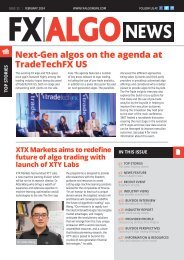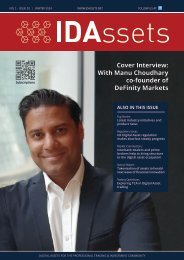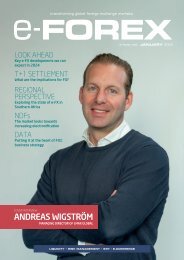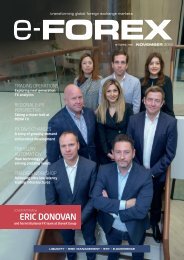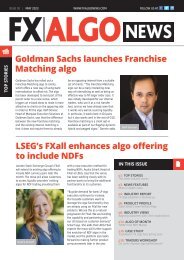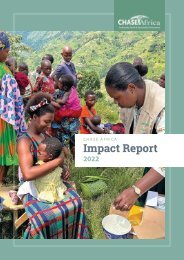You also want an ePaper? Increase the reach of your titles
YUMPU automatically turns print PDFs into web optimized ePapers that Google loves.
The Nordics: Demand for digital FX services is now focused on more sophistication through proven technology<br />
REGIONAL E-FX PERSPECTIVE<br />
“Initially, treasuries focus on automating what they have<br />
done before,but eventually, they discover that automation<br />
enables them to do new things.”<br />
Matti Honkanen<br />
“Treasury automation is an<br />
evolutionary process,” he says,<br />
“with the most advanced treasuries<br />
improving all the time, while others<br />
start their automation journey. Initially,<br />
treasuries focus on automating what<br />
they have done before, but eventually,<br />
they discover that automation<br />
enables them to do new things. This<br />
move from cost and time savings<br />
to increased profits and decreased<br />
risk is where things become more<br />
interesting.”<br />
When asked about broader<br />
technological innovations that might<br />
impact FX, Trujillo points to payments.<br />
“There is a lot happening in the<br />
payment space that will eventually<br />
have an impact on FX,” she says.<br />
“Some of these changes happened<br />
a few years back but are starting to<br />
materialise now.”<br />
She highlights the example of the<br />
PSD2 directive. “It has not drastically<br />
changed the landscape yet but<br />
changes are definitely coming,” she<br />
says. “Nordic banks like SEB have also<br />
incorporated the opportunities and<br />
threats it represents into its strategy<br />
and there is a big FX component in<br />
that.”<br />
Both Trujillo and Honkanen point to<br />
existing technology as the primary<br />
driver of change, both in the<br />
broad market and in applications<br />
like treasury automation. “The<br />
technologies that revolutionise<br />
treasuries are not necessarily<br />
revolutionary themselves,”<br />
Honkanen explains. “Rather, the<br />
way existing, old, and “boring”<br />
technologies are used is what<br />
makes a difference.” He cautions<br />
that getting the basics right is<br />
more important than adopting<br />
fancy technology. “Hiring people<br />
with basic technical skills is more<br />
important than hiring an army of<br />
AI experts. Put them together with<br />
the people who know the treasury<br />
functions and practices inside out,<br />
and the magic follows.”<br />
As an example of existing or “boring”<br />
tech powering innovation, Trujillo<br />
cites the humble API, long a mainstay<br />
of the technological landscape. “API<br />
adoption continues to play a big role<br />
in the development of future-proof<br />
solutions going from the SMEs all<br />
the way to our largest corporates and<br />
financial institutions,” she says. “It<br />
broadens perspectives and connects<br />
systems from pre to post-trade in<br />
a much more efficient way. At SEB,<br />
we help our clients implement these<br />
APIs, whether integrated or not with<br />
third-party solutions, to fit their<br />
challenges and automate as much of<br />
their workflow as possible.”<br />
“APIs have been available in FX for<br />
many years,” she continues. “Smaller<br />
clients have preferred Rest APIs for<br />
some time now but even bigger firms<br />
that were typically focused on FIX are<br />
seeing the advantages of the versatility<br />
and ease of use of Rest APIs.”<br />
When asked about the impact of<br />
this API-first approach on a client’s<br />
choice of trading platforms, Trujillo<br />
explains that integration, instead<br />
of a platform’s size, is the critical<br />
differentiator. “The popular platforms<br />
are still the first choice in the region,”<br />
she says. “They are established and<br />
the plug-in is easier. They are also<br />
very well connected to different<br />
client systems. This means changing<br />
main platforms is quite unusual and<br />
definitely requires a lot of work from<br />
the clients.”<br />
Despite this, she says, smaller<br />
players are having success. “It<br />
usually happens when the client<br />
is undertaking some major<br />
technological change and is reviewing<br />
the possibilities in their FX workflows.<br />
In those cases, both smaller platforms<br />
with good integration capabilities, or<br />
APIs or a combination of both can be<br />
the final choice.”<br />
Honkanen notes that given the<br />
relative familiarity the market has<br />
with existing tech, getting started<br />
is the most important step. “I am<br />
not a great believer in detailed preplanning,”<br />
he says. “You don’t really<br />
know what lies ahead before you<br />
start the journey. Instead, acquire<br />
some basic technical knowledge and<br />
collaborate with a team of seasoned<br />
treasury managers and technology<br />
experts.”<br />
And what would this look like in<br />
practice? “Identify low-hanging fruit<br />
that instil confidence throughout the<br />
company and provide the financial<br />
means to fund the next stages,”<br />
he says. “Don’t try mapping all<br />
the possible needs you might have<br />
now, let alone in the future, before<br />
taking off. The greatest danger is<br />
analysis paralysis when your plans<br />
get increasingly more detailed, and<br />
you realise there are even more<br />
unknowns.”<br />
26 MAY 20<strong>23</strong> e-FOREX




